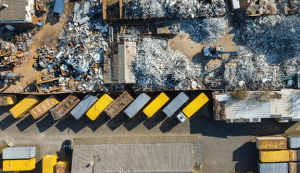
 Contributed by Trey Hess P.E., Director of Brownfields and Economic Development, PPM Consultants
Contributed by Trey Hess P.E., Director of Brownfields and Economic Development, PPM Consultants
When I started my career at the Mississippi Department of Environmental Quality (MDEQ) in 1993, one of my first duties was the review of industrial process waste profiles that had been submitted from companies across the state. They would include a description of the waste material, along with a physical and chemical analysis of the waste characteristics and a certification from the generator that the “waste is not a regulated hazardous waste under Subtitle C of the Federal Resource Conservation and Recovery Act (RCRA) or the Mississippi Hazardous Waste Management Regulations.” Many of the profiles would include laboratory analytical data for the waste using the Toxicity Characteristic Leaching Procedure (TCLP), or Test Method 1311, found in the U.S. EPA publication SW-846. Many others were woefully incomplete.
Importance of Waste Characterization
Facilities generating hazardous and nonhazardous waste need to know the composition of their waste. This understanding is achieved through waste characterization, which typically involves laboratory testing, a deep understanding of the waste generation process, and meticulous documentation. Such documentation is critical for justifying the characterization during inspections and audits. Failing to do so has consequences. Mistakes or misinterpretations of regulatory requirements do happen, but ignorance of the law is not an excuse. Penalties and/or fines can be small or large and depends on a number of factors. In an extreme case, a person who generates, stores, treats, transports, disposes of, exports, or otherwise handles hazardous waste and knowingly alters, destroys, conceals, or fails to file records required to be maintained or filed pursuant to Subtitle C of RCRA could face a criminal penalty of 5 years in prison and/or up to $50,000 per day violation (40 CFR 260-265).
Toxicity Characteristic Leaching Procedure (TCLP) and The Rule of 20
A key component of solid waste characterization is assessing waste toxicity through the Toxicity Characteristic Leaching Procedure (TCLP) or Test Method 1311 as outlined in the U.S. EPA publication SW-846. The TCLP test determines a waste’s likelihood to leach toxic metals, organic compounds, or pesticides into the soil or groundwater under landfill conditions. The results are expressed in milligrams per Liter (mg/L) but are often listed as parts per million (ppm).
Total Waste Analysis vs. TCLP
A total waste analysis determines the total concentration of a contaminant in a sample and is typically reported in milligrams per kilogram (mg/kg). It too is often referred to as parts per million (ppm). Whereas ppm is a volume-to-volume or mass-to-mass ratio, mg/l is a mass-to-volume relationship. A total waste analysis can be useful for identifying unknown chemicals in a waste stream and is often cheaper and faster than a TCLP test. The results from a total waste analysis can act as a screening tool and may eliminate the need for additional testing.
The “Rule of 20” is a concept derived from the TCLP procedure, which can be used to estimate whether a waste would characterize as hazardous. It is a screening tool and should be thoroughly evaluated by a qualified environmental professional since it is a “rule of thumb” and does not apply to all chemicals of concern or every circumstance. This rule leverages the TCLP’s 20:1 dilution ratio. If the total concentration of a chemical in a waste sample is less than 20 times the TCLP regulatory limit, the sample is unlikely to leach enough of the chemical to be considered hazardous when extracted using the TCLP method.
Here’s how the Rule of 20 works:
- Total Concentration Calculation: The total concentration of each chemical in a sample is divided by 20.
- Comparison to TCLP Regulatory Limits: The resulting value is compared to the TCLP regulatory limits for each constituent. If the result is less than the regulatory limit, the waste is typically not classified as “toxicity characteristic” hazardous waste. Remember, this is a rule of thumb.
For example, the RCRA TCLP toxicity limit for arsenic is 5.0 mg/L. A waste with a TCLP concentration greater than 5.0 mg/L would be considered a hazardous waste. If the total arsenic concentration in a waste sample is 70 mg/kg, the waste cannot leach enough arsenic to exceed the TCLP limit because dividing the total concentration of arsenic of 70 mg/kg by 20 would be 3.5 mg/L, which is less than the TCLP regulatory limit of 5 mg/L. Therefore, the sample would not be considered characteristically hazardous for arsenic, though it may require analysis for other constituents.
There are caveats to the Rule of 20:
- If 1/20th of the total analysis result exceeds the RCRA TCLP toxicity limit, further sampling is recommended, and the waste should be treated as hazardous until confirmed otherwise.
- The Rule of 20 is a screening tool; the final determination on additional sampling requirements is made by the permitted disposal facility.
Practical Implementation of Waste Analysis
Industry, as generators of waste, must ensure that their waste analysis is accurate and compliant with regulatory requirements. We, at PPM, can assist you with your waste analysis. Here are some steps and considerations for effective waste characterization:
- Use of Reputable Laboratories: Some states require the use of state-certified labs for waste analysis. These labs follow standardized procedures to ensure accurate and reliable results.
- Documentation and Record-Keeping: Facilities must maintain detailed records of their waste generation processes and analysis results. This documentation should be readily accessible for inspections by regulatory agencies.
- Screening and Total Waste Analysis: Before conducting a TCLP test, a total waste analysis can serve as a preliminary screening tool. If the total concentration of a contaminant is significantly below the TCLP regulatory limit, further TCLP testing may not be necessary.
- Understanding TCLP Test Procedures: Familiarity with the TCLP test procedures is crucial. The test involves a detailed process of mixing, tumbling, filtering, and analyzing samples to simulate landfill conditions and measure leachate concentrations.
- Interpreting Results Using the Rule of 20: The Rule of 20 provides a simplified approach to interpreting total waste analysis results. By dividing the total concentration by 20 and comparing it to regulatory limits, facilities can make informed decisions about the hazardous nature of their waste.
- Handling Hazardous Waste: If initial analysis indicates that waste may be hazardous, it should be managed as such until further testing confirms its status. Proper handling and disposal of hazardous waste are essential to prevent environmental contamination and regulatory violations.
Accurate waste characterization is essential for compliance with environmental regulations and the protection of human health and the environment. By understanding the processes involved in waste analysis, utilizing the Rule of 20, and maintaining thorough documentation, facilities can effectively manage their hazardous and non-hazardous waste. While facilities are ultimately responsible for the proper disposal of the wastes that are generated at your facility, having a qualified environmental consultant, like PPM Consultants, Inc. is a good way to have some assurances that you are doing the right thing with disposal and regulatory compliance.

